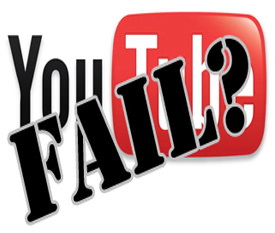
We see it time and again. A great video, hosted on the brand new YouTube channel of a business or organization. It's clear that a lot of time/thought/money went into creating the video. (Good intern!) However, many other elements concerning the video posting haven't been considered. (Bad intern.) This pains us greatly. (And we are, of course, kidding in our title when we blame it on the intern.)
But seriously, for the most part, folks are wasting their YouTube video posting efforts by not following very basic (and free!) best practices. Instead of spending 2 minutes to publish a YouTube video, spend the 10 minutes it takes to do it correctly. Your video message will reach more people with a higher impact. End of story. Here are the 6 "fails" we most often see.
1) No active links in the video description field
Make sure to include the full web address of your business or organization in the video description. It will automatically turn into a hyperlink and connect the person viewing your video to your website in one click.
2) No branding or poor branding
YouTube videos can be shared and embedded on many platforms. If your video is taken out of the context of your own channel, does it still have your brand connected to it? It should! At the very least, make sure branding exists in the video description and, if needed, in the title itself.
3) No call to action
What do you want people do after they watch your awesome online video? Visit your webpage? Make an appointment? Send an email to enter a contest? Share the video on social media? Make sure to include one clear "call to action" in the video description.
4) Titles, descriptions and tags that have not been carefully considered
VSEO stands for Video Search Engine Optimization. YouTube is currently the #2 search engine in the world (Google is #1) and YouTube provides many tools to help your video get discovered via search. VSEO basics include using relevant keywords in your video title, description and tags. Take a moment to think critically about what keywords could represent your video. And remember, the title you created internally for the piece is often not effective in terms of keywords and VSEO.
5) No chapter markers on a long video
Don't necessarily believe what you hear about people not being willing to watch a video of more than 60 seconds. That's not always true, especially if the video is compelling and the topic is of interest to the viewer. However, people online DO want the ability to get to specific points in the content quickly. If your video is longer than 60 seconds use chapter markers in your description to create short cuts for viewers. For example, if you have a video of a ribbon cutting event with different introductory speakers, include the time codes when each new speaker is seen in the video. YouTube makes this really easy. Simply type the timecode "1:30" into the description and a marker is created at 1 minute and 30 seconds into the video. A viewer can then read your video description, see the highlighted 1:30 and click on it - it will take them to that part of the video immediately.
6) Boring or unflattering thumbnails (don't rely on defaults!)
Generally you are given 3 options for the thumbnail image that will represent your video. Choose wisely. The one that YouTube defaults to might not always be the best one. Pick an image that is engaging and entices the viewer to watch your video.
